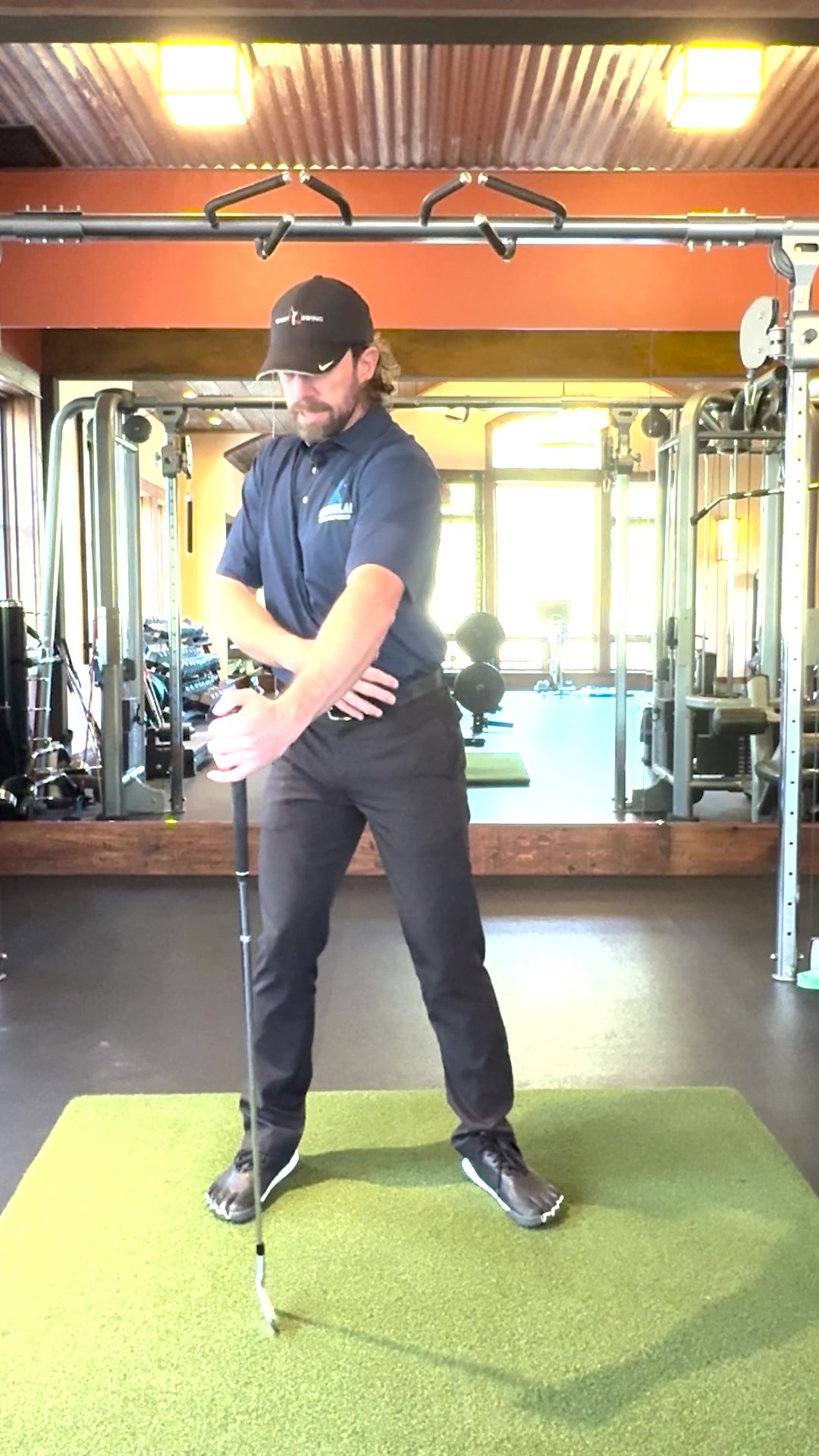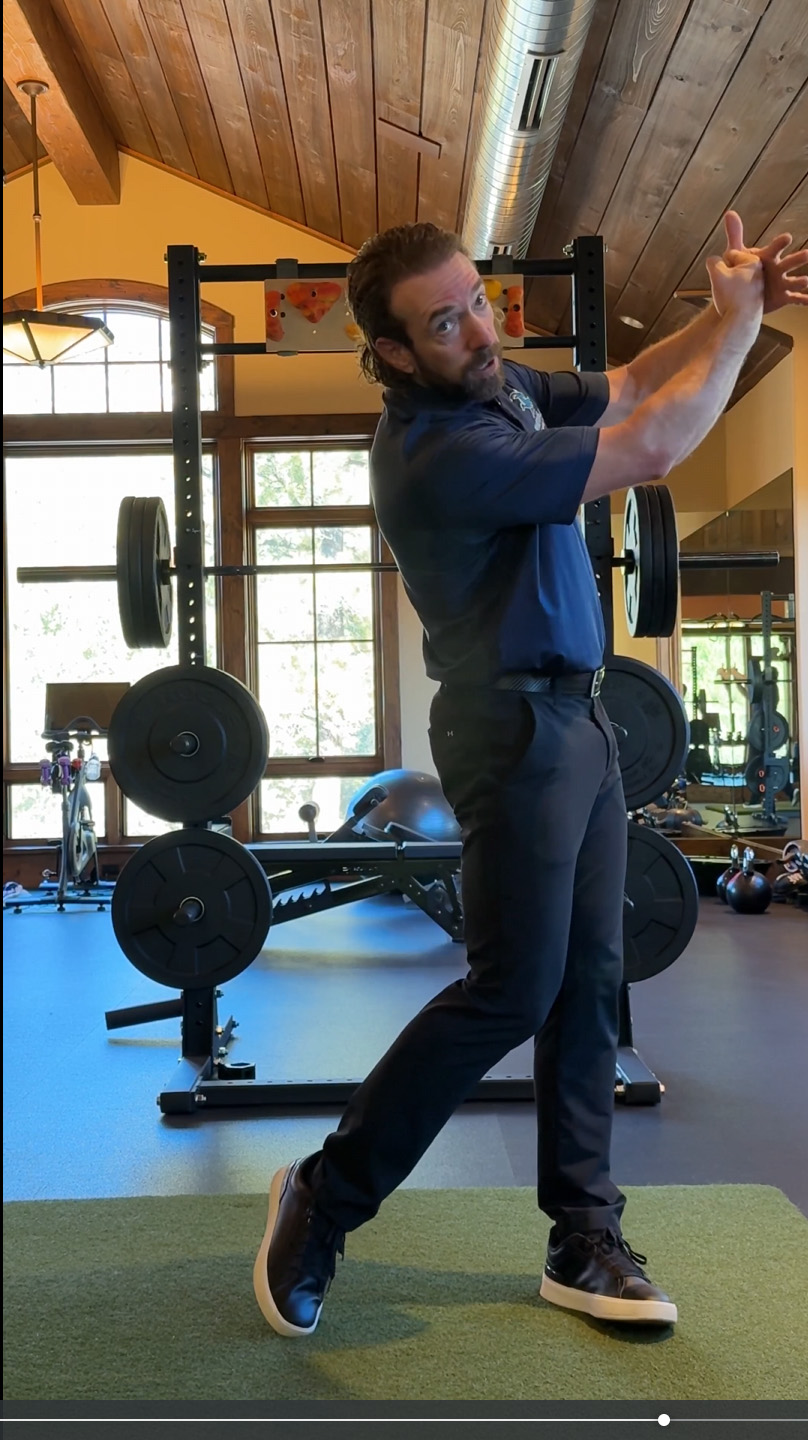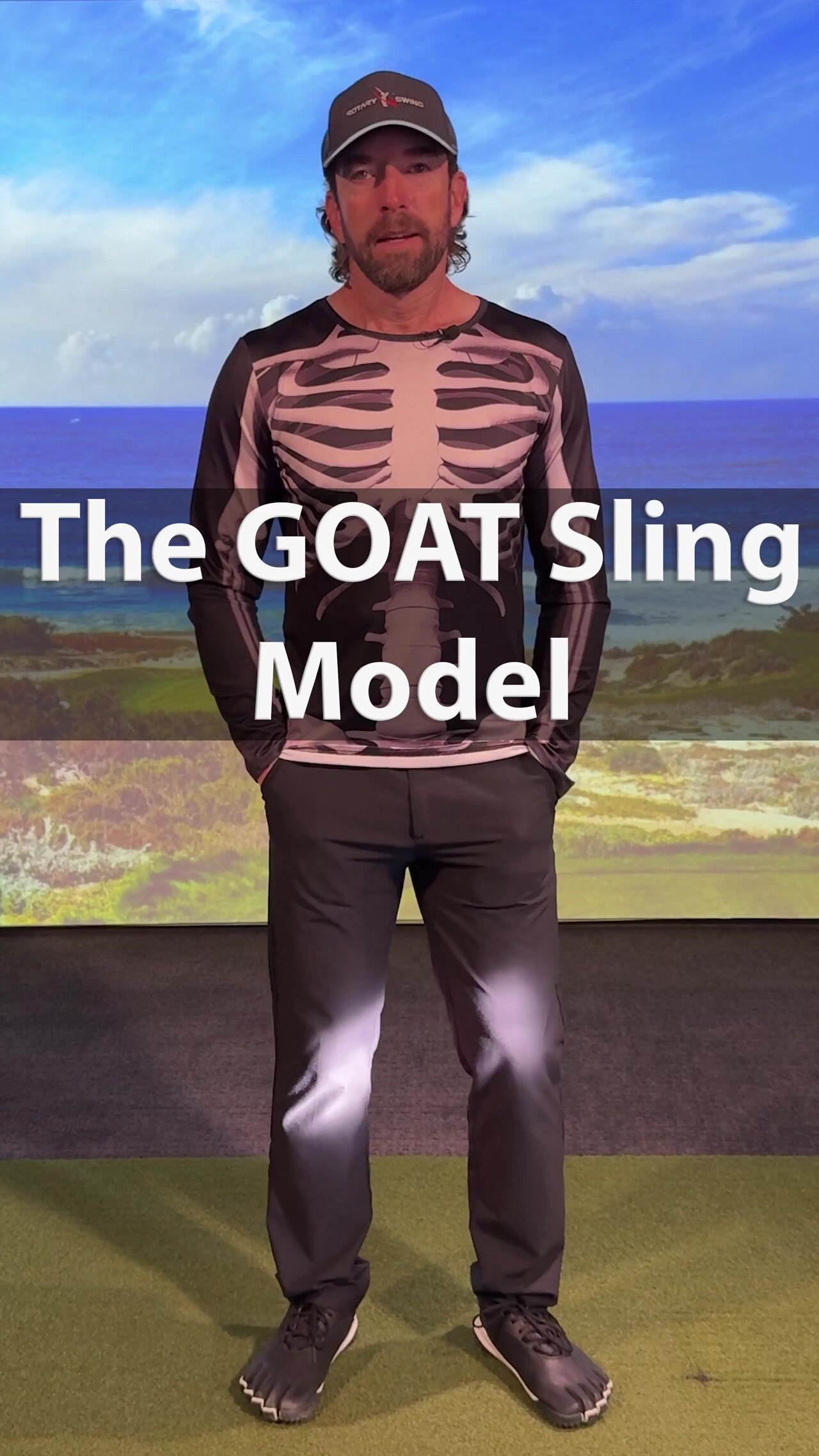Video Menu
My Favorite Videos
My Favorite Videos
How to Hit a Wedge Shot | Penetrating Wedge Shots
Sorry, you need to be a member to access this video.
You Are Just Seconds Away - Become a member here!
Already a member? Log in now

One of the biggest areas needing improvement in the typical amateur's golf game is how to hit flat, penetrating wedge shots that go the needed distance and stop on a dime. In this video, I discuss the three keys to hitting these crucial scoring shots so that you can get up and down more often from this critical yardage. In the photo below, you can see two of the keys being demonstrated in this 60* wedge shot.
- Many amateurs struggle with wedge shots, losing distance because they hit them too high
- There are three keys to solid, flat, penetrating wedge shots
- Number 1 - Set up with the buttons on your shirt in front of the ball
- Number 2 - Shorten up the backswing by putting most of your weight on the left foot
- Number 3 - Make a controlled release that matches the shorter backswing
One of the most common questions I get about the RST system is, how does this apply to the short game?
My simple answer is it doesn't.
RST is all about producing power through efficiency, using biomechanics, physics, anatomy, leverage, etc.
The short game has a completely different set of requirements.
What are you trying to do with the short game?
Are you trying to hit your 60 degree wedge, which I have here, 130 yards?
I hope not.
That's kind of stupid.
Why would you want to hit this club so far?
It's what your pitching wedge is for.
You're not trying to produce power.
As you move down the set of clubs that you have, the more and more you're concerned about accuracy.
I'm not overly concerned with accuracy hitting a three wood into a par five.
It's important, But I'm far more concerned about being super precise with a 60 degree wedge when I'm anywhere from 30 yards to 90 yards outside of the hole.
Now, as you start moving down the distance chart, the more the mechanics of the stroke are going to start changing.
Here's the reason why.
To hit this thing full, so for me to hit a 60 degree wedge, to hit it full speed, is going to go about 90 yards, give or take a little bit.
As I start going closer and closer, the main thing that's going to change is the trajectory.
In most cases, I'm going to start hitting it lower and lower and lower.
Why is that?
Think about this way.
If you're playing a game of lawn darts, if you're far away, you got to hit the ball pretty high to get or throw the lawn dart pretty high to get it there.
But as you get closer and closer, if you're throwing a lawn dart three feet, you're not going to throw it 30 feet in the air to try and throw it three feet.
That doesn't make any sense.
That's why when you watch guys on tour, they hit really low, hard spinning wedge shots.
That's the shot I'm going to teach you today is how to hit a penetrating wedge shot that will bore through the wind.
Take one hop and skip forward and then stop.
That's critical because that first skip, when it lands, you want it to land going in the direction that you hit it.
A lot of times when you hit the ball really high, there's so many little imperfections in the green that when it's coming straight down, it typically won't go in the direction you want it to.
It'll kind of bounce off line one way or the other.
The lower you hit the ball, the more it's going to tend to skip forward in the direction that you hit it, which is hopefully at the flag where you're intended to target is.
So as I move further back or further closer to the green, I start changing the fundamentals of my swing.
Now, if I'm going to make a full swing with this thing, it's going to look like a normal golf swing.
So I'll just hit a quick one here.
This will be a 90 yard, six degree wedge.
So really high, actually almost hit the flag, really high, straight on line.
But as that ball is coming down, it's going to come down, it's going to take a kick either way.
If it's windy, it's going to be very hard for me to control that ball.
I don't want to hit that unless I've got to hit a full shot, which I won't always do with a 60 to hit it that far.
I may grab my sand wedge and knock it down a little bit.
But now let's say I've got the same club, but I need to hit 60 yards instead of 90 yards.
I'm not going to hit it straight up in the air.
So what do I start changing in my swing mechanics and my setup to allow for me to hit this penetrating ball flight?
I'm glad you asked because I'm going to show you.
So my normal setup, even with that wedge shot, is going to be still off my left ear.
As I start moving closer to the green, the ball starts moving further and further back.
Now that's going to start creating all kinds of little, complicated changes in my swing path and plane if I don't make compensations for it.
So for instance, if I made a full swing with the ball back of my stance here, where I may sometimes hit a 60 degree wedge, which is way back, and I made a proper weight shift, I'm going to skull this thing.
So what am I going to do?
I'm not going to shift my weight nearly as much.
I'm not going to make this big shift to the right and to the left, because weight shift is all about energy transfer and creating momentum, which is for power.
I don't need power now.
What I need is control.
So as I start moving it back, there's going to be a lot less weight shift going back and forth during the swing.
Everything's going to start to quiet down because again, my requirements for this shot are different than a full swing.
Now, one other thing that's going to change is that I'm going to have less time to release the clubface.
In a full swing, when the ball is up here, even though it may only be a couple inches difference, That couple inches buys more time for the clubface to start to rotate.
Closed by the time I hit the ball.
Now as it's back here, technically that clubface should be swinging into out with an open clubface, unless I do something to manipulate it with my hands, Which I don't want to do because it kind of defeats the whole purpose of being accurate with my wedge.
So what I am going to do is as I take the club back, I'm going to take it back a little bit more closed so that I don't have to flip my hands over as I release the golf club.
That's going to make it much, Much easier for me to release the club with a lot less effort and get the clubface squared up as I come through.
So now as I take the club back, clubface is going to be more closed and then as I come through, I'm not going to have to try and flip my hands over.
So I'll show you what that's going to look like.
So now I'm at about a 60 yard shot, ball's a little bit back on my stance, buttons on my shirt are more on top of the ball instead of being back here behind it.
So now now I hit a much more driving, penetrating shot because as I deal off the club and the ball's back in my stance, I'm going to have a little more shaft lean, a little bit deeper divot which is going to drive the ball more forward.
As I get closer and closer to the green, this will start to change a little bit more.
So now if I'm going to hit one say 30 yards, this is about as far back as I'd ever move it.
I'm going to have a little more shaft lean address.
I'm going to take the clubface back a little more closed and drive it down through the wind with a little baby punch shot.
So hopefully that helps you understand that the requirements for a full swing, high shot, lots of power versus a penetrating low shot getting through the wind are completely different.
And so you will start making little setup changes, moving the ball back in your stance, having less weight transfer.
You're going to start a little bit more on the left side, a small amount, and just kind of make a tiny shift to the right and to the left going back.
But the big key is taking the clubface back a little more closed, A little more body oriented coming through because you're trying to have less power and more control in your swing.






































































































































































































































































































































































































































































































Jamie
Craig (Certified RST Instructor)
gordon
Chuck
Ronald
Chuck
Dave
Craig (Certified RST Instructor)
Lee
Chris (Certified RST Instructor)
Todd
Craig (Certified RST Instructor)
Amaury
Craig (Certified RST Instructor)
Amaury
Elmir
Craig (Certified RST Instructor)
Jim
Craig (Certified RST Instructor)
Kevin
Craig (Certified RST Instructor)
Kyaw Thet
Craig (Certified RST Instructor)
Kevin
Craig (Certified RST Instructor)
Matthew
Craig (Certified RST Instructor)
Matthew
Craig (Certified RST Instructor)
Matthew
Craig (Certified RST Instructor)
Matthew
Matthew
Craig (Certified RST Instructor)
gordon
Craig (Certified RST Instructor)
Kevin
Craig (Certified RST Instructor)
Mark
Craig (Certified RST Instructor)
Mark
Craig (Certified RST Instructor)
Mark
Craig (Certified RST Instructor)
Mark
Craig (Certified RST Instructor)
James
Craig (Certified RST Instructor)
James
Craig (Certified RST Instructor)
David
Craig (Certified RST Instructor)
David
Craig (Certified RST Instructor)
Julie
Craig (Certified RST Instructor)
Julie
Craig (Certified RST Instructor)
Julie
Kevin
Craig (Certified RST Instructor)
Jeffrey
Craig (Certified RST Instructor)
Jeffrey
Craig (Certified RST Instructor)
Jeffrey
Craig (Certified RST Instructor)
Jeffrey
Anthony
Craig (Certified RST Instructor)
Tram
Craig (Certified RST Instructor)
Tram
Craig (Certified RST Instructor)
Chad
Craig (Certified RST Instructor)
Tom
Craig (Certified RST Instructor)
richard
Craig (Certified RST Instructor)
Lawrence
Craig (Certified RST Instructor)
Lawrence
Craig (Certified RST Instructor)
Arnie
Craig (Certified RST Instructor)
Johnny
Craig (Certified RST Instructor)
Johnny
Craig (Certified RST Instructor)
Lawrence
Craig (Certified RST Instructor)
Jarek
Craig (Certified RST Instructor)
gordon
Craig (Certified RST Instructor)
Tom
Craig (Certified RST Instructor)
Lawrence
Craig (Certified RST Instructor)
Lawrence
Kenny
Craig (Certified RST Instructor)
Kenny
Craig (Certified RST Instructor)
Lawrence
Craig (Certified RST Instructor)
Lawrence
Stephen
Craig (Certified RST Instructor)
Stephen
Craig (Certified RST Instructor)
Wyatt
Craig (Certified RST Instructor)
Anthony
Craig (Certified RST Instructor)
GEORGE
Craig (Certified RST Instructor)
Ronald
Craig (Certified RST Instructor)
Brian
Craig (Certified RST Instructor)
Brian
Anthony
Craig (Certified RST Instructor)
Tyler (Certified RST Instructor)
Craig (Certified RST Instructor)
Frank
Craig (Certified RST Instructor)
martin
Craig (Certified RST Instructor)
martin
Craig (Certified RST Instructor)
gordon
Craig (Certified RST Instructor)
gordon
Craig (Certified RST Instructor)
Steven
Craig (Certified RST Instructor)
Steven
Craig (Certified RST Instructor)
Douglas
Craig (Certified RST Instructor)
Will
Craig (Certified RST Instructor)
Tom
Craig (Certified RST Instructor)
T David
Craig (Certified RST Instructor)
gordon
Craig (Certified RST Instructor)
Michael
Craig (Certified RST Instructor)
Martyn
Chuck
Martyn
John
Chuck
Ronald
Chuck
Don
Chuck
T David
Craig (Certified RST Instructor)
T David
Diarmuid
Craig (Certified RST Instructor)
Daniel
Craig (Certified RST Instructor)
David
Craig (Certified RST Instructor)
Terry
Terry
David
Craig (Certified RST Instructor)
Zacky
Craig (Certified RST Instructor)
Michael
Craig (Certified RST Instructor)
Martyn
Craig (Certified RST Instructor)
David
Craig (Certified RST Instructor)
Douglas
Craig (Certified RST Instructor)
Douglas
gordon
Craig (Certified RST Instructor)
T David
Craig (Certified RST Instructor)
David
Craig (Certified RST Instructor)
Rod
Micah (Certified RST Instructor)
Craig
Craig (Certified RST Instructor)
Gareth
Craig (Certified RST Instructor)
Juan
Craig (Certified RST Instructor)
Mitchell
Craig (Certified RST Instructor)
Michael
Craig (Certified RST Instructor)
Adam
Craig (Certified RST Instructor)
Eric
Craig (Certified RST Instructor)
Ron
Craig (Certified RST Instructor)
Michael
Craig (Certified RST Instructor)
Michael
Craig (Certified RST Instructor)
Lance
Craig (Certified RST Instructor)
Mark
Chris (Certified RST Instructor)
Greg
Chris (Certified RST Instructor)
Seth
Craig (Certified RST Instructor)
Lance
Craig (Certified RST Instructor)
gordon
Craig (Certified RST Instructor)
gordon
Craig (Certified RST Instructor)
Arnie
Craig (Certified RST Instructor)
Roderick
Craig (Certified RST Instructor)
gordon
Craig (Certified RST Instructor)
gordon
Craig (Certified RST Instructor)
Shlok
Craig (Certified RST Instructor)
Shlok
Craig (Certified RST Instructor)
Scott
Craig (Certified RST Instructor)
Bob
Craig (Certified RST Instructor)
David
Chris (Certified RST Instructor)
Kyle
Craig (Certified RST Instructor)
Kyle
David
Craig (Certified RST Instructor)
Brandon
Craig (Certified RST Instructor)
Robert
Craig (Certified RST Instructor)
Robert
Craig (Certified RST Instructor)
Paul
Craig (Certified RST Instructor)
Marcus
Craig (Certified RST Instructor)
Braden
Craig (Certified RST Instructor)
Braden
Craig (Certified RST Instructor)
Jose
Craig (Certified RST Instructor)
Frank
Craig (Certified RST Instructor)
Micah (Certified RST Instructor)
Craig (Certified RST Instructor)
Joseph
Craig (Certified RST Instructor)
Dave
Craig (Certified RST Instructor)
Dave
Craig (Certified RST Instructor)
Dave
Craig (Certified RST Instructor)
Dave
Lance
Craig (Certified RST Instructor)
William
Craig (Certified RST Instructor)
Andrew
Craig (Certified RST Instructor)
Evan
Craig (Certified RST Instructor)
Dave
Craig (Certified RST Instructor)
gordon
Craig (Certified RST Instructor)
Larry
Craig (Certified RST Instructor)
Larry
Esteban
Craig (Certified RST Instructor)
dennis
Craig (Certified RST Instructor)
Jared
Craig (Certified RST Instructor)
Jared
Craig (Certified RST Instructor)
Virgil
Craig (Certified RST Instructor)
gordon
Craig (Certified RST Instructor)
gordon
Craig (Certified RST Instructor)
gordon
Craig (Certified RST Instructor)
gordon
JENA
Craig (Certified RST Instructor)
leslie
Craig (Certified RST Instructor)
Miguel
Craig (Certified RST Instructor)
Colin
Craig (Certified RST Instructor)
ejm
Craig (Certified RST Instructor)
Mark
Craig (Certified RST Instructor)
gordon
Craig (Certified RST Instructor)
gordon
Craig (Certified RST Instructor)
gordon
Craig (Certified RST Instructor)
Mads
Craig (Certified RST Instructor)
Chae
Craig (Certified RST Instructor)
Alejandro
Steven (Certified RST Instructor)
Mike
Craig (Certified RST Instructor)
Andrew
Craig (Certified RST Instructor)
Chris (Certified RST Instructor)
Craig (Certified RST Instructor)
John
Craig (Certified RST Instructor)
Ron
R.J. (Certified RST Instructor)
myron
Craig (Certified RST Instructor)
Edvin
R.J. (Certified RST Instructor)
Joe
Craig (Certified RST Instructor)
Erich
Craig (Certified RST Instructor)
Eric
Craig (Certified RST Instructor)
Kyle
Craig (Certified RST Instructor)
Jackie (Certified RST Instructor)
Craig (Certified RST Instructor)
Jitu
DENIS
Craig (Certified RST Instructor)
James
Craig (Certified RST Instructor)
JAMES
Craig (Certified RST Instructor)
JAMES
Craig (Certified RST Instructor)
JAMES
Craig (Certified RST Instructor)
Nick
Craig (Certified RST Instructor)
jeffrey
Craig (Certified RST Instructor)
Rich
Craig (Certified RST Instructor)
Ji
Craig (Certified RST Instructor)
Brandon
Steven
Craig (Certified RST Instructor)
Benjamin
Craig (Certified RST Instructor)
gary
Craig (Certified RST Instructor)
patrick14
Craig (Certified RST Instructor)
Wen
Craig (Certified RST Instructor)
patrick14
Craig (Certified RST Instructor)
john
Craig (Certified RST Instructor)
patrick14
Craig (Certified RST Instructor)
David
Craig (Certified RST Instructor)
patrick14
Chris (Certified RST Instructor)
patrick14
patrick14
patrick14
Greg
Craig (Certified RST Instructor)
Junior
Craig (Certified RST Instructor)
charles
Chris (Certified RST Instructor)
James
Chris (Certified RST Instructor)
Chris (Certified RST Instructor)
Chris (Certified RST Instructor)
ashley
Chris (Certified RST Instructor)
ashley
patrick14
Chris (Certified RST Instructor)
Greg
Chris (Certified RST Instructor)
Nick
Ste
Chris (Certified RST Instructor)
john
bryan
René (Certified RST Instructor)
charles
Chris (Certified RST Instructor)